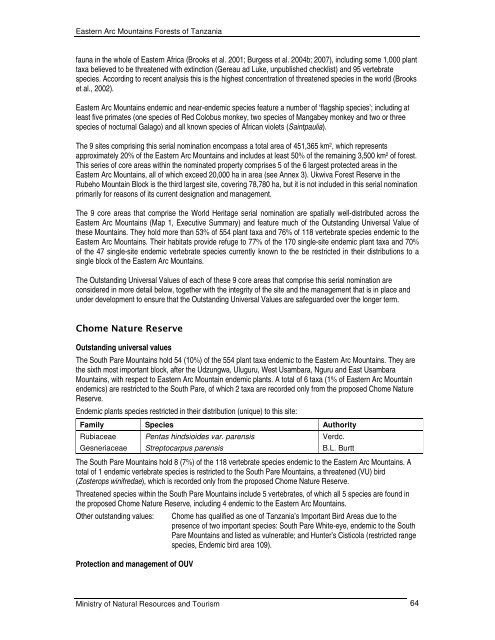eastern arc mountains forests of tanzania - Campaign for the ...
eastern arc mountains forests of tanzania - Campaign for the ...
eastern arc mountains forests of tanzania - Campaign for the ...
You also want an ePaper? Increase the reach of your titles
YUMPU automatically turns print PDFs into web optimized ePapers that Google loves.
Eastern Arc Mountains Forests <strong>of</strong> Tanzania<br />
fauna in <strong>the</strong> whole <strong>of</strong> Eastern Africa (Brooks et al. 2001; Burgess et al. 2004b; 2007), including some 1,000 plant<br />
taxa believed to be threatened with extinction (Gereau ad Luke, unpublished checklist) and 95 vertebrate<br />
species. According to recent analysis this is <strong>the</strong> highest concentration <strong>of</strong> threatened species in <strong>the</strong> world (Brooks<br />
et al., 2002).<br />
Eastern Arc Mountains endemic and near-endemic species feature a number <strong>of</strong> ‘flagship species’; including at<br />
least five primates (one species <strong>of</strong> Red Colobus monkey, two species <strong>of</strong> Mangabey monkey and two or three<br />
species <strong>of</strong> nocturnal Galago) and all known species <strong>of</strong> African violets (Saintpaulia).<br />
The 9 sites comprising this serial nomination encompass a total area <strong>of</strong> 451,365 km 2 , which represents<br />
approximately 20% <strong>of</strong> <strong>the</strong> Eastern Arc Mountains and includes at least 50% <strong>of</strong> <strong>the</strong> remaining 3,500 km 2 <strong>of</strong> <strong>for</strong>est.<br />
This series <strong>of</strong> core areas within <strong>the</strong> nominated property comprises 5 <strong>of</strong> <strong>the</strong> 6 largest protected areas in <strong>the</strong><br />
Eastern Arc Mountains, all <strong>of</strong> which exceed 20,000 ha in area (see Annex 3). Ukwiva Forest Reserve in <strong>the</strong><br />
Rubeho Mountain Block is <strong>the</strong> third largest site, covering 78,780 ha, but it is not included in this serial nomination<br />
primarily <strong>for</strong> reasons <strong>of</strong> its current designation and management.<br />
The 9 core areas that comprise <strong>the</strong> World Heritage serial nomination are spatially well-distributed across <strong>the</strong><br />
Eastern Arc Mountains (Map 1, Executive Summary) and feature much <strong>of</strong> <strong>the</strong> Outstanding Universal Value <strong>of</strong><br />
<strong>the</strong>se Mountains. They hold more than 53% <strong>of</strong> 554 plant taxa and 76% <strong>of</strong> 118 vertebrate species endemic to <strong>the</strong><br />
Eastern Arc Mountains. Their habitats provide refuge to 77% <strong>of</strong> <strong>the</strong> 170 single-site endemic plant taxa and 70%<br />
<strong>of</strong> <strong>the</strong> 47 single-site endemic vertebrate species currently known to <strong>the</strong> be restricted in <strong>the</strong>ir distributions to a<br />
single block <strong>of</strong> <strong>the</strong> Eastern Arc Mountains.<br />
The Outstanding Universal Values <strong>of</strong> each <strong>of</strong> <strong>the</strong>se 9 core areas that comprise this serial nomination are<br />
considered in more detail below, toge<strong>the</strong>r with <strong>the</strong> integrity <strong>of</strong> <strong>the</strong> site and <strong>the</strong> management that is in place and<br />
under development to ensure that <strong>the</strong> Outstanding Universal Values are safeguarded over <strong>the</strong> longer term.<br />
Chome Nature Reserve<br />
Outstanding universal values<br />
The South Pare Mountains hold 54 (10%) <strong>of</strong> <strong>the</strong> 554 plant taxa endemic to <strong>the</strong> Eastern Arc Mountains. They are<br />
<strong>the</strong> sixth most important block, after <strong>the</strong> Udzungwa, Uluguru, West Usambara, Nguru and East Usambara<br />
Mountains, with respect to Eastern Arc Mountain endemic plants. A total <strong>of</strong> 6 taxa (1% <strong>of</strong> Eastern Arc Mountain<br />
endemics) are restricted to <strong>the</strong> South Pare, <strong>of</strong> which 2 taxa are recorded only from <strong>the</strong> proposed Chome Nature<br />
Reserve.<br />
Endemic plants species restricted in <strong>the</strong>ir distribution (unique) to this site:<br />
Family Species Authority<br />
Rubiaceae Pentas hindsioides var. parensis Verdc.<br />
Gesneriaceae Streptocarpus parensis B.L. Burtt<br />
The South Pare Mountains hold 8 (7%) <strong>of</strong> <strong>the</strong> 118 vertebrate species endemic to <strong>the</strong> Eastern Arc Mountains. A<br />
total <strong>of</strong> 1 endemic vertebrate species is restricted to <strong>the</strong> South Pare Mountains, a threatened (VU) bird<br />
(Zosterops winifredae), which is recorded only from <strong>the</strong> proposed Chome Nature Reserve.<br />
Threatened species within <strong>the</strong> South Pare Mountains include 5 vertebrates, <strong>of</strong> which all 5 species are found in<br />
<strong>the</strong> proposed Chome Nature Reserve, including 4 endemic to <strong>the</strong> Eastern Arc Mountains.<br />
O<strong>the</strong>r outstanding values: Chome has qualified as one <strong>of</strong> Tanzania’s Important Bird Areas due to <strong>the</strong><br />
presence <strong>of</strong> two important species: South Pare White-eye, endemic to <strong>the</strong> South<br />
Pare Mountains and listed as vulnerable; and Hunter’s Cisticola (restricted range<br />
species, Endemic bird area 109).<br />
Protection and management <strong>of</strong> OUV<br />
Ministry <strong>of</strong> Natural Resources and Tourism 64


